Effect of Welding Process on Microstructural and Mechanical Characteristics of Hardox 600 Steel
Abstract
:1. Introduction
- −
- The problem of “unhardened layer” (“soft layer”) occurs in heat-affected zone, deciding strength of the entire structure;
- −
- The changes occurring in heat-affected zones of welded joints of steels that were, before welding, hardened or hardened and low-tempered only, lead to the creation of zones with lowered hardness and tensile strength resulting from tempering processes in the temperature range between 250 °C and AC1 (according to Fe-Fe3C diagram);
- −
- By proper selection of chemical composition of additional materials and optimum selection of welding conditions and parameters, structures and mechanical properties close to those of the base material can be obtained in HAZ with no additional operations;
- −
- Application of limited welding energy makes it possible to obtain narrow degraded zone (“soft layer”) which does not result in lower mechanical properties of the weld.
- −
- Identification of macro- and microscopic structures of welded joints of Hardox 600 in as-delivered condition with determination of the extent of structural changes within the entire joint; and
- −
- Producing, by heat treatment, structural changes of the joint in order to eliminate or to minimise the changes caused by welding.
2. Material and Methodology
- −
- Non-consumable electrode: tungsten with thorium oxide;
- −
- Maximum current for individual weld layers: I = 90 A;
- −
- Voltage of electric arc: U = 9.5 V;
- −
- Approximate welding speed: v = 140 mm/min;
- −
- Shielding gas: 99.99% argon;
- −
- Flow of shielding gas: 10 L/min;
- −
- Interpass temperature: Ti < 400 °C; and
- −
- Welding energy: Q < 0.5 kJ/mm.
3. Results
3.1. Mechanical Properties
3.2. Results of Microscopic Observations and Hardness Measurements
3.3. Results of Fractographic Analysis
4. Discussion
5. Conclusions
- −
- The welding operation causes variable microstructure changes in the entire joint, resulting in lowered hardness in comparison to the base material. These changes can be characterised as a decomposition of the original Hardox 600 structure, as a result of thermal action, to structures characteristic for quenching and tempering, as well as to morphologically non-homogeneous hardening structures.
- −
- As a result of the performed post-welding heat treatment, structural transformation occurred in the entire area of the joint consisting, first of all, in replacement of the “degraded” structure by the structure morphologically similar to that of as-delivered steel Hardox 600.
- −
- Tensile strength values of the welded joint (871 MPa) and very high impact strength (163 J/cm2) confirm the possibility to weld the Hardox 600 steel, even if this material has a high carbon equivalent (CEV) much higher than the value of 0.45 accepted as safe. This statement was additionally confirmed by fractographic analysis of impact-test specimens.
- −
- Mechanical properties of the Hardox 600 joints after heat treatment showed that the initial properties of the steel can be reconstructed with respect to both microstructures and selected mechanical properties. It was shown that, after heat treatment, the average tensile strength is 1386 MPa, however, the maximum tensile strength that can be reached is 1562 MPa, i.e., 78% of the nominal value of Hardox 600, which should be treated as a guideline for stabilizing the welding process. The tensile strength value of 1562 MPa can be treated in spite of the high-strength properties of the welded joint, and favourable plastic properties were maintained, manifested by quite high impact strength (42 J/cm2) and dominating part of the ductile fracture revealed by fractographic analysis.
- −
- The information obtained from this research, referring to the application of additional heat-treatment of welded joints of Hardox 600, clearly indicate the possibility of regenerating their “degraded” structural and mechanical properties.
Author Contributions
Conflicts of Interest
References
- Adamczyk, J. Engineering of Metallic Materials; Wydawnictwo Politechniki Śląskiej: Gliwice, Poland, 2004. (In Polish) [Google Scholar]
- Zdravecka, E.; Tkacova, J.; Ondac, M. Effect of microstructure factors on abrasion resistance of high-strength steels. Res. Agric. Eng. 2014, 60, 115–120. [Google Scholar]
- Hui, W.; Dong, H.; Weng, Y.; Shi, J.; Nie, Y.; Chu, Z.; Chen, Y. Delayed fracture behavior of ultrafine grained high strength steel. Acta Metall. Sin. 2004, 40, 561–568. [Google Scholar]
- En, Z.; Jumaev, N.; Usmanova, M.M.; Kim, H.J.; Ho, J.W.; Jang, J.; Brenizer, J.S. Application of SSNTDs for study of boron distribution in alloys. Radiat. Meas. 1997, 28, 363–368. [Google Scholar] [CrossRef]
- Hansson, P.; Lowgren, C. Properties of modern wear resistant steels. Svetsen 1990, 1, 58–61. [Google Scholar]
- Badinier, G. The Effect of Carbon Segregation and Carbide Precipitation on the Mechanical Response of Martensite. Ph.D. Thesis, University of British Columbia, Vancouver, BC, Canada, May 2013. [Google Scholar]
- Kuziak, R.; Kawalla, R.; Waengler, S. Advanced high strength steels for automotive industry. Arch. Civ. Mech. Eng. 2008, 8, 103–117. [Google Scholar] [CrossRef]
- Adamiak, M.; Górka, J.; Kik, T. Comparison of abrasion resistance of selected constructional materials. J. Achiev. Mater. Manuf. Eng. 2009, 37, 375–380. [Google Scholar]
- Matlock, D.K.; Speer, J.G. Third generation of AHSS: Microstructure design concepts. In Microstructure and Texture in Steels; Haldar, A., Suwas, S., Bhattacharjee, D., Eds.; Springer: London, UK, 2009; pp. 185–205. ISBN 978-1-84882-454-6. [Google Scholar]
- Ilsenburger Grobblech GmbH. Available online: http://www.ilsenburger-grobblech.de/fileadmin/mediadb/ilg/infocenter/downloads/werkstoffblaetter/eng/abrasion_resistant_brinar400.pdf (accessed on 9 March 2017).
- Ilsenburger Grobblech GmbH. Available online: http://www.ilsenburger-grobblech.de/fileadmin/mediadb/ilg/infocenter/downloads/werkstoffblaetter/eng/abrasion_resistant_brinar500.pdf (accessed on 9 March 2017).
- Hardox Wear Plate-Wear and Abrasion Resistant Steel–SSAB. Available online: http://www.ssab.pl/produkty/marki/hardox (accessed on 9 March 2017).
- Hardox 600 Wear Plate, Abrasion Resistant Steel-Stal-Hurt. Available online: http://www.stal-hurt.com/hardox-trudnoscieralne-blachy/hardox600.html (accessed on 9 March 2017).
- Manufacturer of Abrasion Resistant Parts and Fixtures–Multialloy. Available online: http://www.multialloy.com.br/ing/produtos/pdf/Creusabro_8000.pdf (accessed on 9 March 2017).
- The Steel Service Centre–Flinkenberg Steel. Available online: http://www.flinkenberg.fi/wp-content/uploads/DATASHEET-XAR600.pdf (accessed on 9 March 2017).
- Bugłacki, H.; Smajdor, M. Mechanical properties of abrasion—Resistant Hardox 400 and their welded joints. Adv. Mater. Sci. 2003, 3, 5–8. [Google Scholar]
- Mazur, M.; Ulewicz, R.; Bokuvka, O. The impact of welding wire on the mechanical properties of welded joints. Mater. Eng. 2014, 21, 122–128. [Google Scholar]
- Brezová, E.; Mäsiar, H.; Radic, P. Welding of high strength materials used in the manufacture of special equipment. Univ. Rev. 2014, 8, 51–61. [Google Scholar]
- Uzunali, U.Y.; Cuvalci, H. The effects of post weld heat treatment on the mechanical properties of tempered martensite and high strength steel welded joints. In Proceedings of the 2015 World Congress on Advances in Structural Engineering and Mechanics (ASEM15), Incheon, Korea, 25–29 August 2015. [Google Scholar]
- Pękalski, G.; Haimann, K.; Konat, Ł.; Koniarek, K.; Krugła, M.; Mroczkowski, L.; Orłowski, J.; Oskwarek, M.; Ptak, T.; Szymczak, H. Material Testing of Hardox 400 and Hardox 500; Series SPR 10 Report; Institute of Materials Science and Technical Mechanics: Wroclaw, Poland, 2005. (In Polish) [Google Scholar]
- Cegiel, L.; Konat, Ł.; Pawłowski, T.; Pękalski, G. Hardox steels—New-generation constructional materials of surface-mining machines. Węgiel Brunatny 2006, 3, 24–29. (In Polish) [Google Scholar]
- Konat, Ł.; Pękalski, G.; Oskwarek, M. Macro- and microstructural properties of welded joints of Hardox 400 and Hardox 500 steels. In Proceedings of the XIX Scientific Conference on Development Problems of Working Machines, Zakopane, Poland, 23–26 January 2006. [Google Scholar]
- Konat, Ł. Structures and Properties of Hardox Steels and their Application Possibilities in Conditions of Abrasive Wear and Dynamic Loads. Ph.D. Thesis, Wroclaw University of Technology, Wroclaw, Poland, 2007. (In Polish). [Google Scholar]
- Dudziński, W.; Konat, Ł.; Pękalski, G. Structural and strength characteristics of wear-resistant martensitic steels. Arch. Foundry Eng. 2008, 8, 21–26. [Google Scholar]
- Dudziński, W.; Konat, Ł.; Pękalski, G. Modern constructional steels. In Maintenance Strategy of Surface Mining Machines and Facilities with High Degree of Technical Degradation; Dudek, D., Ed.; Publishing House of Wroclaw University of Technology: Wroclaw, Poland, 2013; pp. 346–366. (In Polish) [Google Scholar]
- Oskwarek, M. Structural features and susceptibility to cracking of welded joints of Hardox 400 and Hardox 500 steels. In Proceedings of the IV Students’ Science Conference: Human-Civilisation-Future, Wroclaw, Poland, 22–24 May 2006; Volume 2, pp. 115–120. [Google Scholar]
- Tasak, E. Metallurgy and Metal Science of Welded Joints; AGH University of Science and Technology: Kraków, Poland, 1985. (In Polish) [Google Scholar]
- Pilarczyk, J. (Ed.) Engineer’s Manual—Welding Technology; WNT: Warsaw, Poland, 2003. (In Polish) [Google Scholar]
- Frydman, S.; Konat, Ł.; Pękalski, G. Structure and hardness changes in welded joints of Hardox steels. Arch. Civ. Mech. Eng. 2008, 8, 15–27. [Google Scholar] [CrossRef]
- Dudziński, W.; Konat, Ł.; Pękalska, L.; Pękalski, G. Structures and properties of Hardox 400 and Hardox 500 steels. Mater. Eng. 2006, 3, 139–142. (In Polish) [Google Scholar]
- Konat, Ł.; Pękalski, G. Structures and selected properties of Hardox steels in the context of their use in surface mining machinery construction. In Proceedings of the XV International Symposium on Mine Planning & Equipment Selection (MPES 2006), Torino, Italy, 20–22 September 2006. [Google Scholar]
- Łętkowska, B. Influence of Heat Treatment on Structure and Selected Properties of B27 and 28MCB5 Steels. Ph.D. Thesis, Wroclaw University of Technology, Wroclaw, Poland, 2013. (In Polish). [Google Scholar]
- Dudziński, W.; Białobrzeska, B.; Konat, Ł. Comparative analysis of structural and mechanical properties of selected low-alloy boron-containing abrasive-wear resistant steels. In Polish Metallurgy in the Years 2011–2014; Świątkowski, K., Ed.; Akapit: Kraków, Poland, 2014; pp. 871–888. (In Polish) [Google Scholar]
- Pawlak, K.; Białobrzeska, B.; Konat, Ł. The influence of austenitizing temperature on prior austenite grain size and resistance to abrasion wear of selected low-alloy boron steel. Arch. Civ. Mech. Eng. 2016, 16, 913–926. [Google Scholar] [CrossRef]
- Białobrzeska, B.; Konat, Ł.; Jasiński, R. The influence of austenite grain size on the mechanical properties of low-alloy steel with boron. Metals 2017, 7, 26. [Google Scholar]
- Frydman, S.; Konat, Ł.; Białobrzeska, B.; Pękalski, G. Impact resistance and fractography of low-alloy martensitic steels. Arch. Foundry Eng. 2008, 8, 89–94. [Google Scholar]
- Dudziński, W.; Konat, Ł.; Białobrzeska, B. Fractographic analysis of selected boron steels subjected to impact testing. Arch. Metall. Mater. 2015, 60, 2373–2378. [Google Scholar] [CrossRef]
- Napiórkowski, J.; Konat, Ł.; Ligier, K. The structural properties and resistance to abrasive wear in soil of Creusabro steel. Tribologia 2016, 47, 105–119. [Google Scholar]
- Konat, Ł.; Napiórkowski, J.; Kołakowski, K. Resistance to wear as a function of the microstructure and selected mechanical properties of microalloyed steel with boron. Tribologia 2016, 47, 101–114. [Google Scholar]
- Graville, B.A. Cold Cracking in welds in HSLA steels, welding of HSLA (Microalloyed) structural steels. In Proceedings of the AIM/ASM Conference, Rome, Italy, 9–12 November 1976. [Google Scholar]
- ESAB. Available online: http://www.skladbaildon.pl/PDF-2012/1-pridavne-svarovaci-materialy/D18/OK_Aristorod_89.pdf (accessed on 9 September 2016).
- Lincoln Electric. Available online: http://www.lincolnelectric.com/assets/global/products/consumableeu_migwires-ultramag-ultramag/ultramag-pl.pdf (accessed on 9 September 2016).
- Wyrzykowski, J.W.; Pleszakow, E.; Sieniawski, J. Deformation and Cracking of Metals; WNT: Warszawa, Poland, 1999. (In Polish) [Google Scholar]
- Lin, C.-M.; Lu, C.-H. Effects of tempering temperature on microstructural evolution and mechanical properties of high-strength low-alloy D6AC plasma arc welds. Mater. Sci. Eng. A 2016, 676, 28–37. [Google Scholar] [CrossRef]
- Wang, C.; Wang, M.; Shi, J.; Hui, W.; Dong, H. Effect of Microstructure Refinement on the Strength and Toughness of low alloy martensitic steel. J. Mater. Sci. Technol. 2007, 23, 659–664. [Google Scholar]
- Maciejny, A. Brittleness of Metals; Publishing House Śląsk: Katowice, Poland, 1973. (In Polish) [Google Scholar]
- Mills, K.; American Society for Microbiology (ASM). ASM Handbook Volume 12: Fractography, 9th ed.; ASM International: Russell, OH, USA, 1987. [Google Scholar]
- Ravichandran, K.S.; Vasudevan, A.K. Fracture resistance of structural alloys. In ASM Handbook Volume 19: Fatigue and Fracture; ASM International: Russell, OH, USA, 1996; pp. 381–392. [Google Scholar]
- Horn, R.M.; Ritchie, R.O. Mechanisms of tempered martensite embrittlement in low alloy steels. Metall. Trans. A 1978, 9, 1039–1053. [Google Scholar] [CrossRef]
- Maity, S.K.; Kawalla, R. Ultrahigh strength steel: Development of mechanical properties through controlled cooling. In Heat Transfer—Engineering Applications; Vikhrenko, V., Ed.; InTech: Shanghai, China, 2011; pp. 309–336. [Google Scholar]
- Vishnevsky, C.; Steigerwald, E.A. Influence of Alloying Elements on the Toughness of low Alloy Martensitic High Strength Steels; Final Technical Report; TRW Inc.: Cleveland, OH, USA, 1968. [Google Scholar]
- El-Bitar, T.; Gamilb, M.; Mousab, I.; Helmy, F. Development of carbon—Low alloy steel grades for low temperature applications. Mater. Sci. Eng. A 2011, 528, 6039–6044. [Google Scholar] [CrossRef]
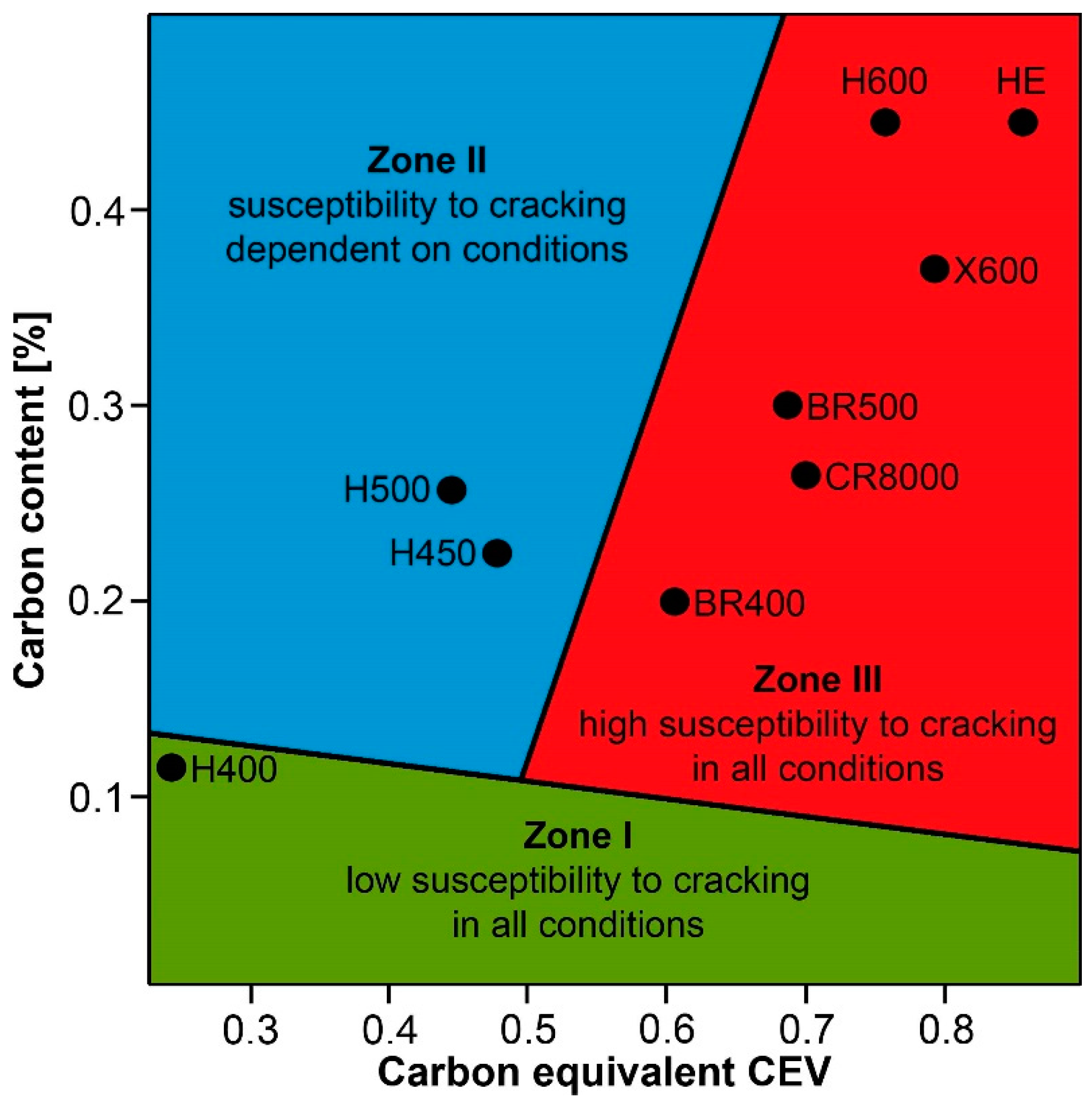
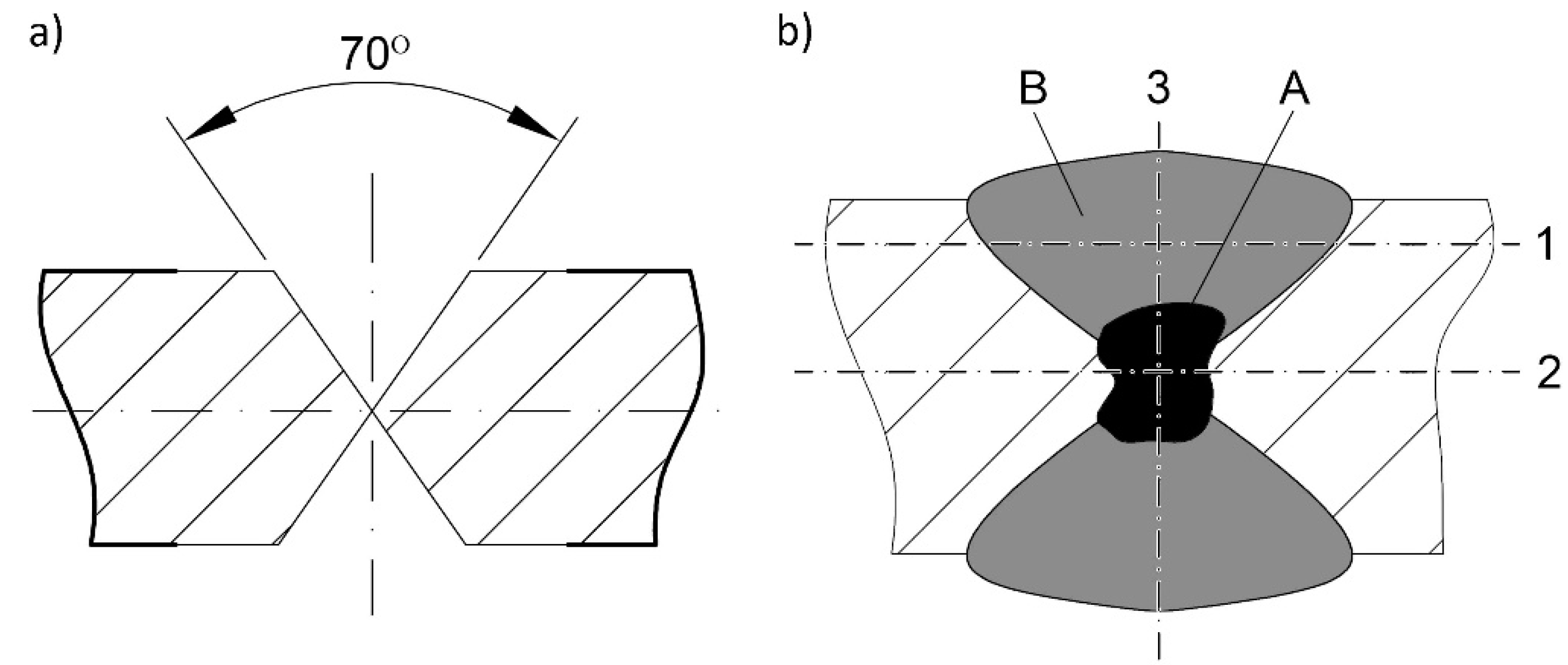
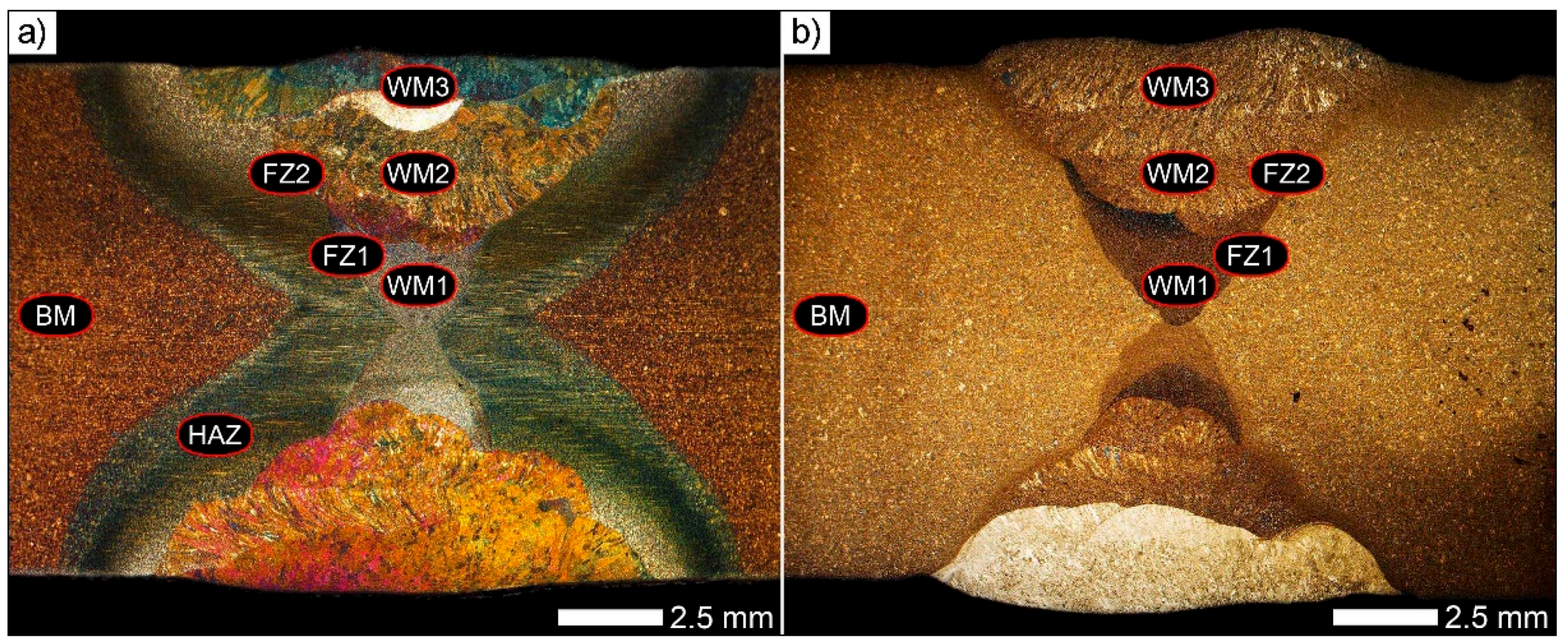
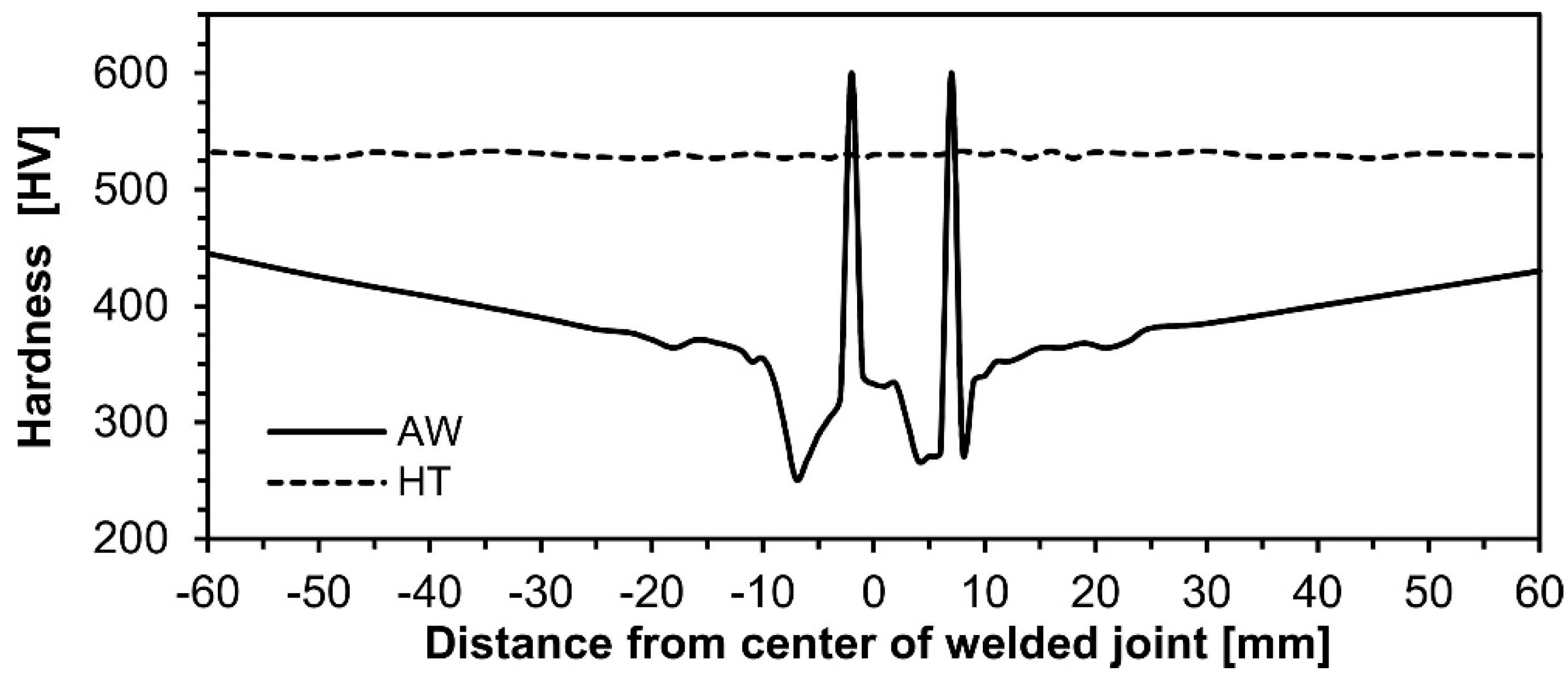


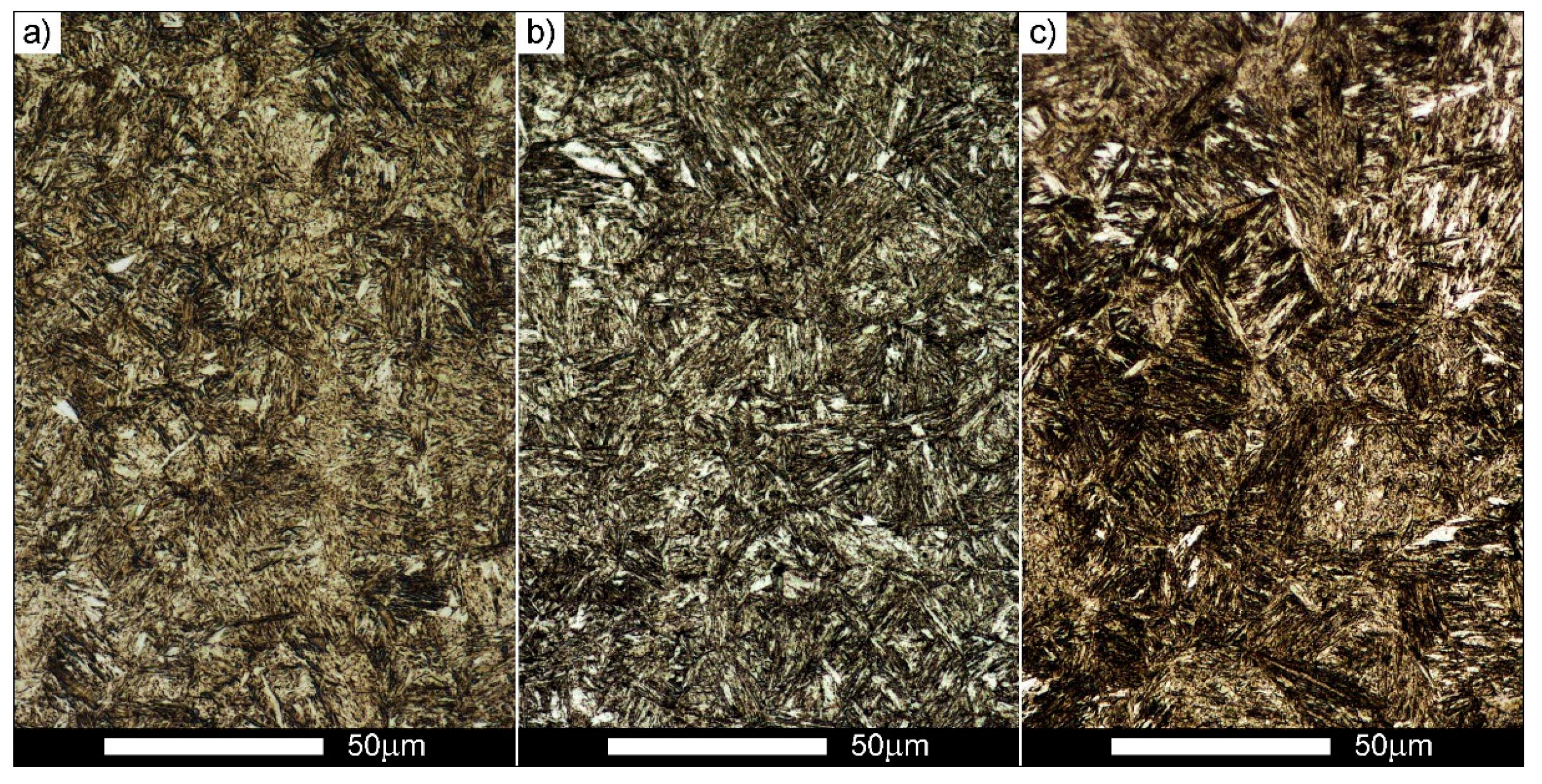

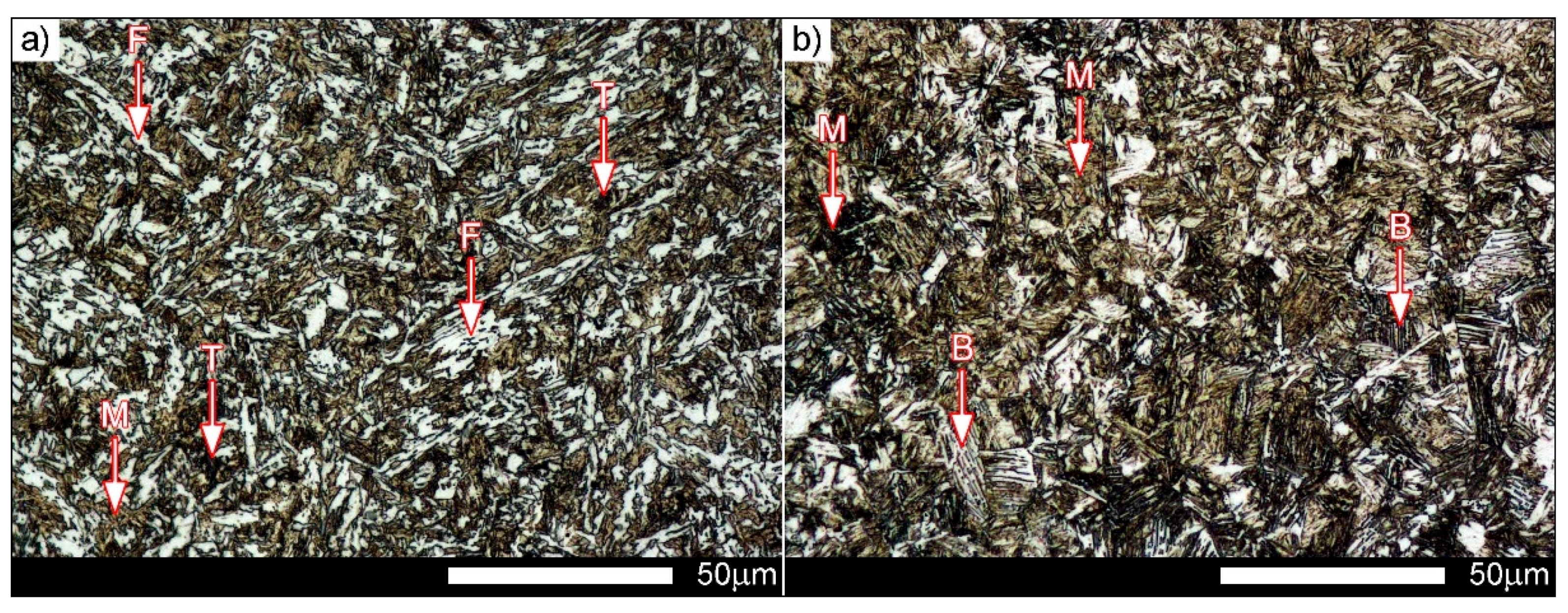
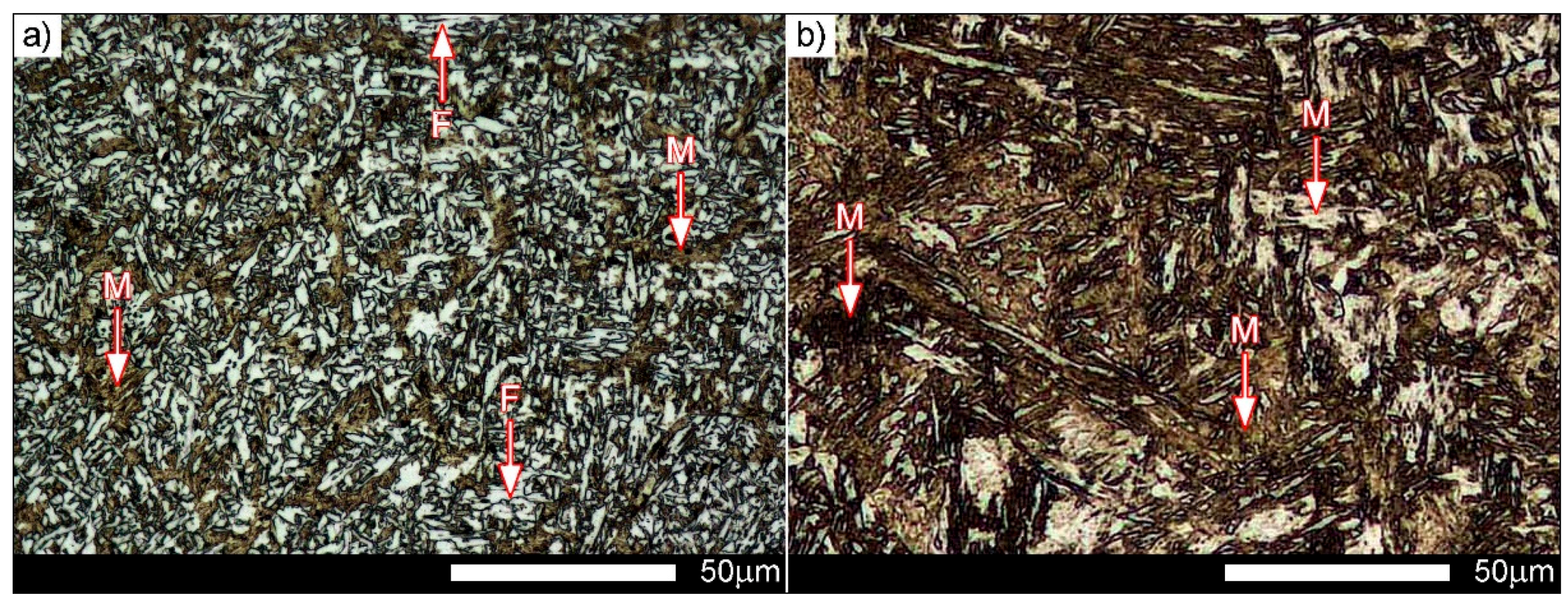
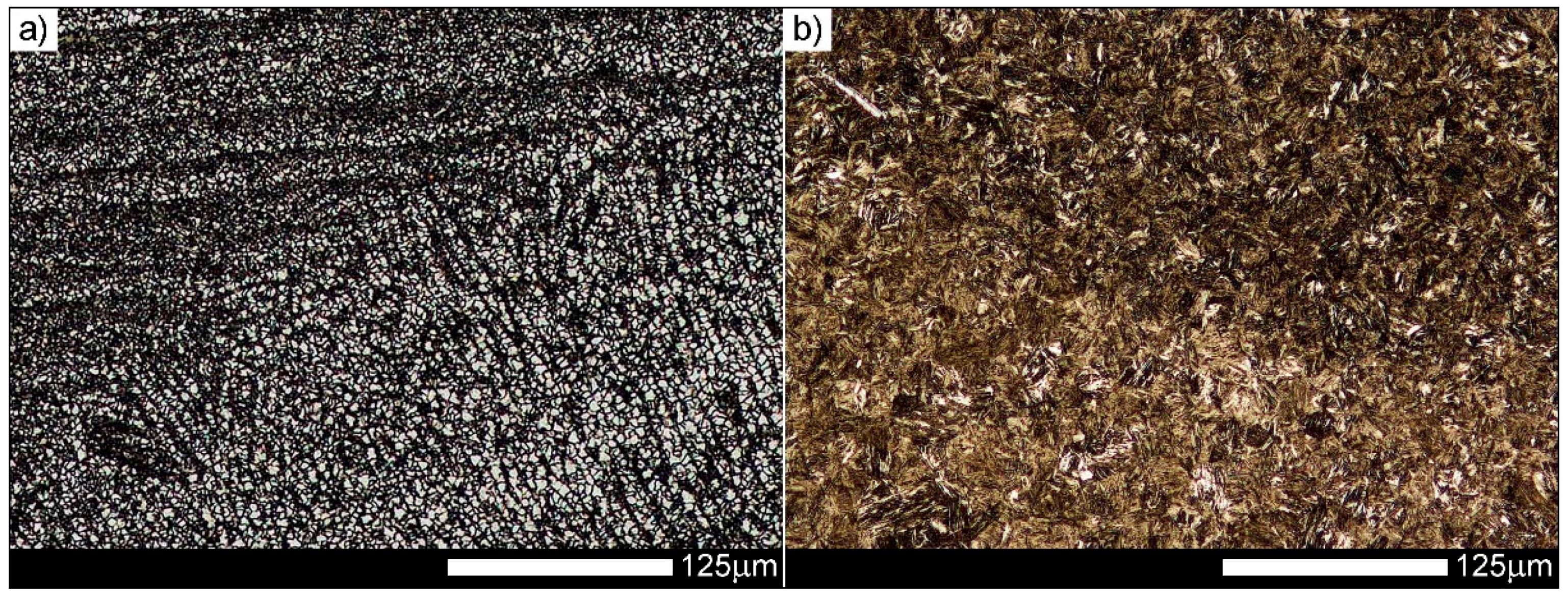
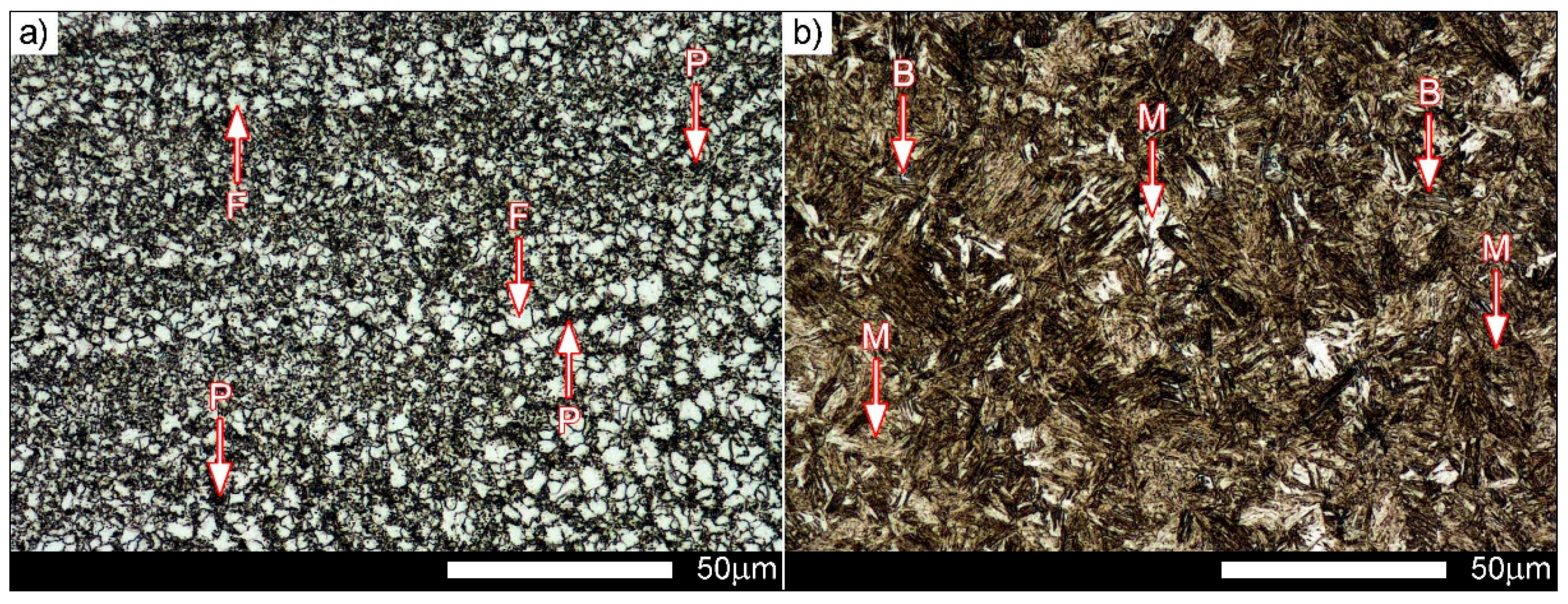


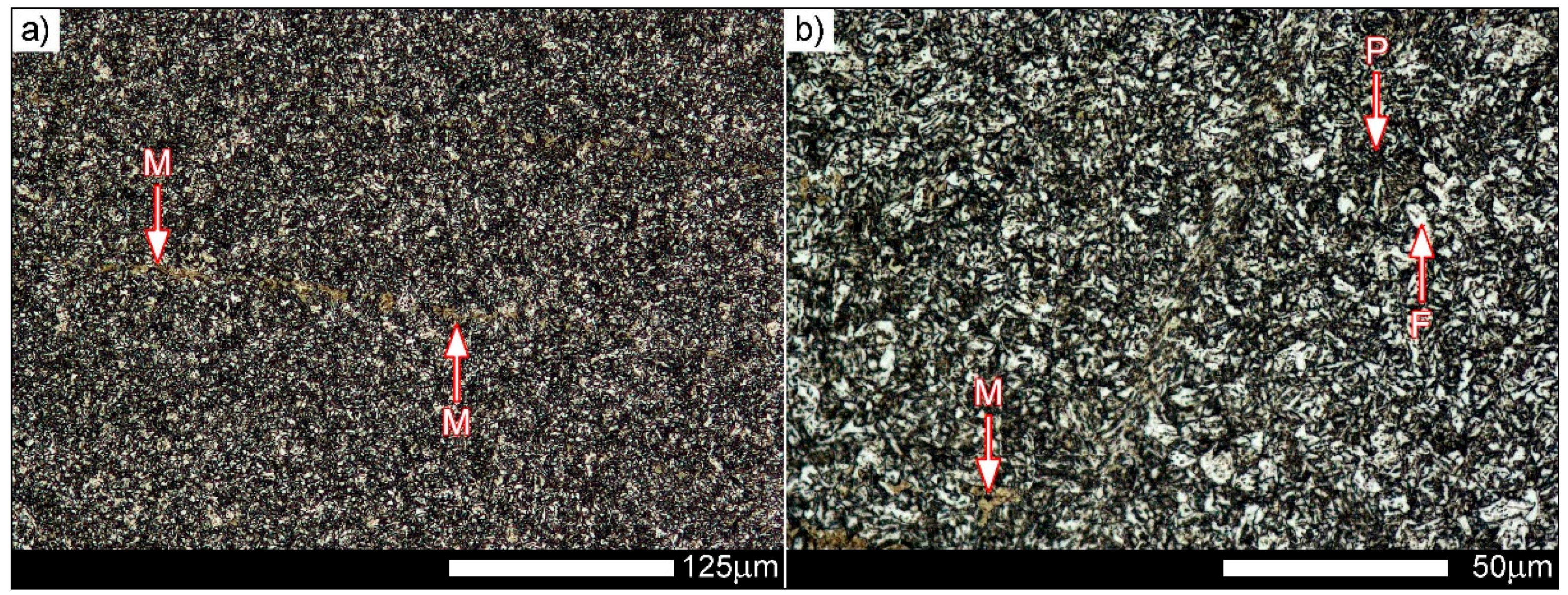

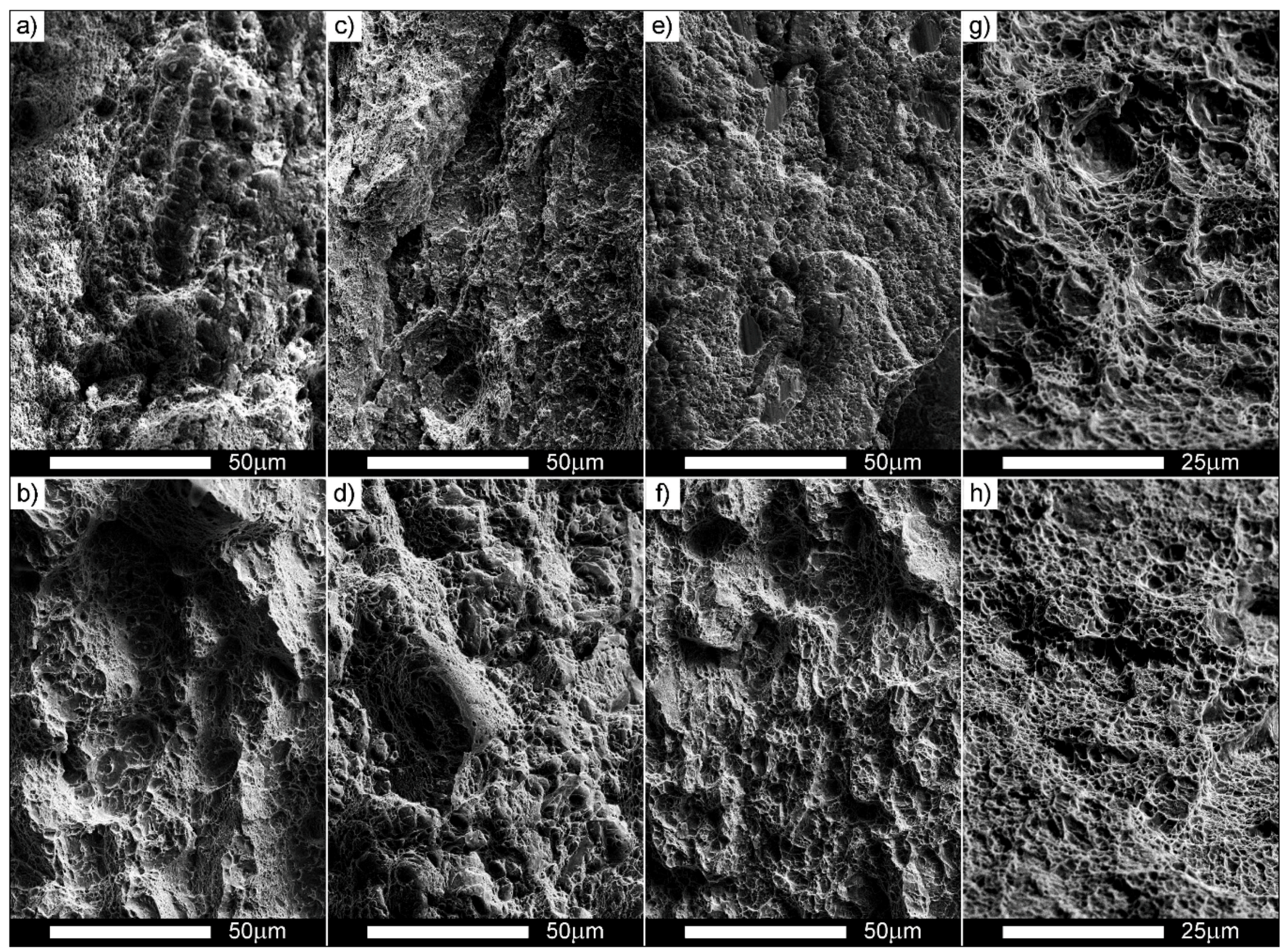
| Steel | Rp0.2 | Rm | A5 | KCV−40 | HBW |
|---|---|---|---|---|---|
| (MPa) | (MPa) | (%) | (J/cm2) | ||
| Brinar 400 | 900 | 1200 | 12 | 25 (−20 °C) | 340–440 |
| Brinar 500 | 1350 | 1500 | 8 | 25 (−20 °C) | 480 |
| Hardox 400 | 1100 | 1250 | 10 | 56 | 370–430 |
| Hardox 450 | 1200 | 1400 | 10 | 50 | 425–475 |
| Hardox 500 | 1400 | 1550 | 10 | 46 | 470–530 |
| Hardox 600 | 1650 | 2000 | 7 | 25 | 570–640 |
| Hardox Extreme | --- | --- | --- | --- | 650–700 |
| Creusabro 8000 | 1250 | 1630 | 12 | ≥40 (−20 °C) | 430–500 |
| XAR 600 | 1700 | 2000 | 8 | 25 (−20 °C) | > 550 |
| Steel Element | Brinar 400 | Brinar 500 | Hardox 400 | Hardox 450 | Hardox 500 | Hardox 600 | Hardox Extreme | Creusabro 8000 | XAR 600 |
|---|---|---|---|---|---|---|---|---|---|
| Max. Concentration (wt %) | |||||||||
| C | 0.18 | 0.28 | 0.14 | 0.21 | 0.27 | 0.45 | 0.47 | 0.28 | 0.40 |
| Mn | 2.00 | 1.50 | 1.60 | 1.60 | 1.60 | 1.00 | 1.40 | 1.60 | 1.50 |
| Si | 0.50 | 0.80 | 0.70 | 0.70 | 0.70 | 0.70 | 0.50 | - | 0.80 |
| P | 0.015 | 0.020 | 0.025 | 0.025 | 0.025 | 0.015 | 0.015 | 0.015 | 0.025 |
| S | 0.005 | 0.005 | 0.010 | 0.010 | 0.010 | 0.010 | 0.010 | 0.005 | 0.010 |
| Cr | 1.55 | 1.50 | 0.30 | 0.50 | 1.00 | 1.20 | 1.20 | 1.60 | 1.50 |
| Ni | - | - | 0.25 | 0.25 | 0.25 | 2.50 | 2.50 | ~0.40 | 1.50 |
| Mo | 0.60 | 0.40 | 0.25 | 0.25 | 0.25 | 0.80 | 0.80 | ≥0.20 | 0.50 |
| B | 0.005 | - | 0.004 | 0.004 | 0.004 | 0.004 | 0.005 | - | 0.005 |
| # (mm) | ≤80 | ≤60 | 3–10 | 10–20 | 4–13 | 8–30 | 8–20 | 5–60 | 15 |
| CEV 1 | - | - | 0.33 | 0.47 | 0.49 | 0.73 | 0.65 | - | 0.79 |
| CET 2 | - | - | 0.23 | 0.34 | 0.34 | 0.55 | 0.54 | - | 0.53 |
| Steel Element | Brinar 400 | Brinar 500 | Hardox 400 | Hardox 450 | Hardox 500 | Hardox 600 | Hardox Extreme | Creusabro 8000 | XAR 600 |
|---|---|---|---|---|---|---|---|---|---|
| Concentration (wt %) | |||||||||
| C | 0.20 | 0.30 | 0.12 | 0.22 | 0.26 | 0.44 | 0.44 | 0.27 | 0.37 |
| Mn | 1.13 | 0.97 | 0.34 | 1.09 | 0.20 | 0.53 | 0.49 | 1.28 | 0.85 |
| Si | 0.23 | 0.60 | 1.05 | 0.28 | 0.75 | 0.17 | 0.16 | 0.70 | 0.19 |
| P | 0.012 | 0.015 | 0.006 | 0.010 | 0.005 | 0.006 | 0.006 | 0.012 | 0.014 |
| S | 0.001 | 0.001 | 0.001 | 0.000 | 0.005 | 0.002 | 0.002 | 0.002 | 0.001 |
| Cr | 0.61 | 0.87 | 0.24 | 0.21 | 0.70 | 0.31 | 0.83 | 0.68 | 0.83 |
| Ni | 0.45 | 0.04 | 0.04 | 0.06 | 0.05 | 2.03 | 2.01 | 0.29 | 1.21 |
| Mo | 0.31 | 0.20 | 0.02 | 0.13 | 0.01 | 0.14 | 0.14 | 0.23 | 0.15 |
| V | 0.040 | 0.005 | 0.004 | 0.004 | 0.005 | 0.006 | 0.008 | 0.002 | 0.002 |
| Cu | 0.030 | 0.020 | 0.006 | 0.004 | 0.004 | 0.011 | 0.018 | 0.200 | 0.030 |
| B | 0.0023 | 0.0008 | 0.002 | 0.0012 | 0.001 | 0.0022 | 0.0021 | 0.0024 | 0.0021 |
| # (mm) | 12 | 12 | 8 | 10 | 10 | 12 | 10 | 15 | 15 |
| CEV | 0.61 | 0.68 | 0.23 | 0.46 | 0.44 | 0.76 | 0.86 | 0.70 | 0.79 |
| CET | 0.39 | 0.46 | 0.17 | 0.38 | 0.32 | 0.58 | 0.60 | 0.47 | 0.54 |
| Weld Metal | C | Mn | Si | Cr | Ni | Mo | Re | Rm | A5 | KCV−40 |
|---|---|---|---|---|---|---|---|---|---|---|
| Chemical Composition (%) | (MPa) | (MPa) | (%) | (J/cm2) | ||||||
| OK Aristorod 89 (GMn4Ni2CrMo) | 0.10 | 1.90 | 0.80 | 0.30 | 2.10 | 0.65 | 920 | 1000 | 18 | 60 |
| UltraMag (G3Si1) | 0.07 | 1.45 | 0.85 | 0.04 | 0.01 | 0.01 | 471 | 580 | 25 | 73 |
| Designation of Test Piece | Condition | Kind and Parameters of Heat Treatment | Rm | KCV+20 | ||
|---|---|---|---|---|---|---|
| (MPa) | (J/cm2) | |||||
| AW-UTS-1 | AW | Untreated | 917 | 871 | --- | |
| AW-UTS-2 | 835 | |||||
| AW-UTS-3 | 862 | |||||
| AW-KCV-1 | --- | 169.2 | 163 | |||
| AW-KCV-2 | 154.4 | |||||
| AW-KCV-3 | 164.6 | |||||
| HT-UTS-1 | HT | Normalizing (N): 900 °C/60 min/air Quenching (Q): 930 °C/15 min/oil Tempering (T): 200 °C/120 min/air | 1266 | 1386 | --- | |
| HT-UTS-2 | 1331 | |||||
| HT-UTS-3 | 1562 | |||||
| HT-KCV-1 | --- | 47.8 | 42 | |||
| HT-KCV-2 | 39.7 | |||||
| HT-KCV-3 | 39.2 | |||||
© 2017 by the authors. Licensee MDPI, Basel, Switzerland. This article is an open access article distributed under the terms and conditions of the Creative Commons Attribution (CC BY) license (http://creativecommons.org/licenses/by/4.0/).
Share and Cite
Konat, Ł.; Białobrzeska, B.; Białek, P. Effect of Welding Process on Microstructural and Mechanical Characteristics of Hardox 600 Steel. Metals 2017, 7, 349. https://doi.org/10.3390/met7090349
Konat Ł, Białobrzeska B, Białek P. Effect of Welding Process on Microstructural and Mechanical Characteristics of Hardox 600 Steel. Metals. 2017; 7(9):349. https://doi.org/10.3390/met7090349
Chicago/Turabian StyleKonat, Łukasz, Beata Białobrzeska, and Paweł Białek. 2017. "Effect of Welding Process on Microstructural and Mechanical Characteristics of Hardox 600 Steel" Metals 7, no. 9: 349. https://doi.org/10.3390/met7090349





